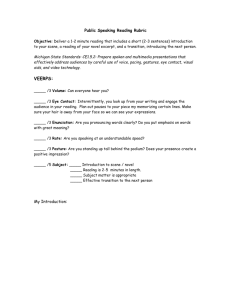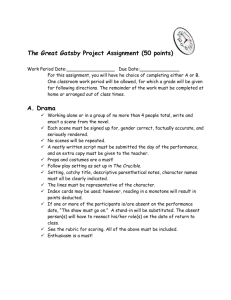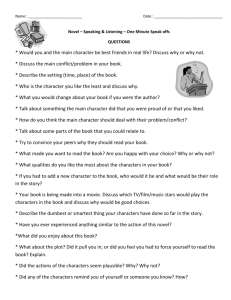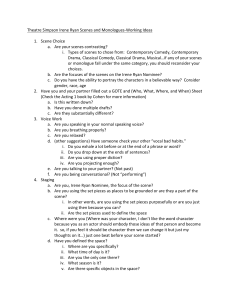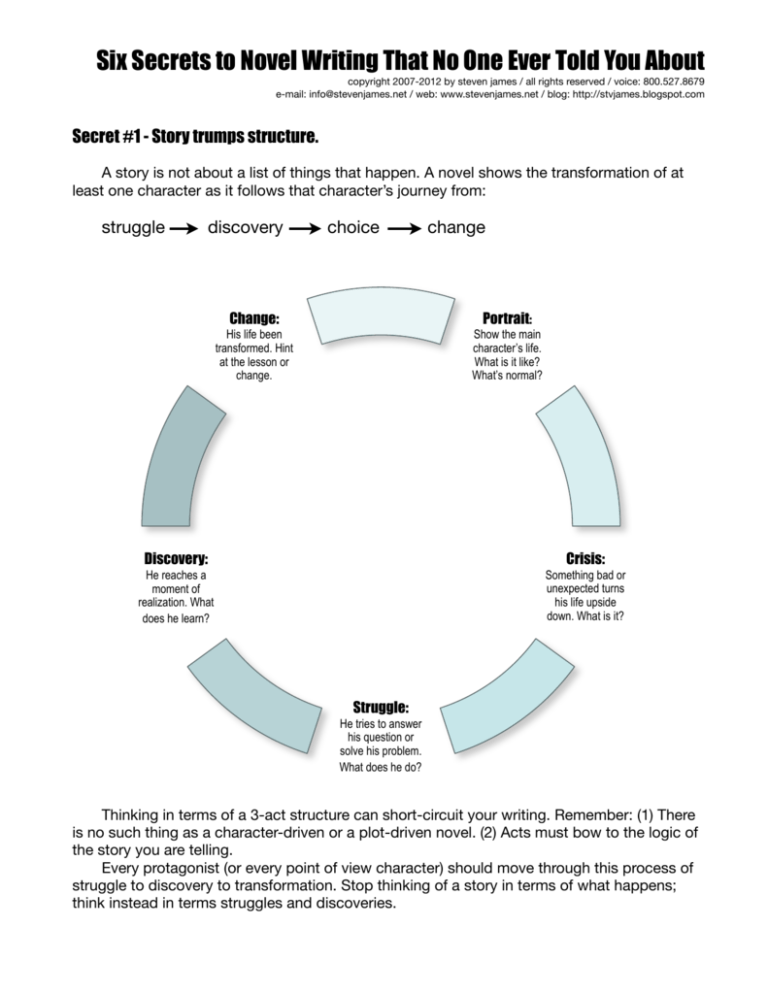
Six Secrets to Novel Writing That No One Ever Told You About
copyright 2007-2012 by steven james / all rights reserved / voice: 800.527.8679
e-mail: info@stevenjames.net / web: www.stevenjames.net / blog: http://stvjames.blogspot.com
Secret #1 - Story trumps structure.
A story is not about a list of things that happen. A novel shows the transformation of at
least one character as it follows that character’s journey from:
struggle discovery
choice change
Portrait:
Show the main
character’s life.
What is it like?
What’s normal?
Change:
His life been
transformed. Hint
at the lesson or
change.
Discovery:
Crisis:
He reaches a
moment of
realization. What
does he learn?
Something bad or
unexpected turns
his life upside
down. What is it?
Struggle:
He tries to answer
his question or
solve his problem.
What does he do?
Thinking in terms of a 3-act structure can short-circuit your writing. Remember: (1) There
is no such thing as a character-driven or a plot-driven novel. (2) Acts must bow to the logic of
the story you are telling.
Every protagonist (or every point of view character) should move through this process of
struggle to discovery to transformation. Stop thinking of a story in terms of what happens;
think instead in terms struggles and discoveries.
Six Secrets to Novel Writing That No One Ever Told You About
copyright 2007-2012 by steven james / all rights reserved / voice: 800.527.8679
e-mail: info@stevenjames.net / web: www.stevenjames.net / blog: http://stvjames.blogspot.com
Secret #2 - Readers want less action and more promises.
Secret #3 - Crafting scenes and interludes is the key to pacing your novel.
The building blocks of a novel are scenes, and the cement that holds them together are
interludes. A scene consists of action; such as you might see on a theater stage. If you can
see the actions onstage in the novel, it’s a scene. If you cannot, it’s probably an interlude.
The scenes in a novel are strung together by interludes during which the characters
_______________ what just happened and make a ______________ that leads to the next
scene. The reader is invited to join the character as she thinks about what just happened, the
emotions that it evoked, and then the new direction for the story. In a scene, a person or a
situation must be altered. If nothing is changed, it’s an unnecessary scene.
Your character will fail his way to success. In other words, whatever your protagonist tries
to accomplish in a scene fails and leads him further on his journey toward success. For
example:
The detective chases the villain through the streets but doesn’t catch him.
Frustrated, she goes back to her hotel room and while she’s taking off her
shoes, she rubs her feet and remembers the chase. While doing so, she realizes
that the villain was limping as he ran. That motivates her to drive across town
and accuse her friend, who recently sprained his ankle, of the crime. Her friend
is angry and shows her that he’s limping on the left leg rather than the right
one. He’s so offended that she would accuse him of the terrible crime that he
says he never wants to see her again. He slams the door in her face and she
returns home, dejected.
Identify the two scenes in the paragraph above:
Identify the interlude:
The amount of time you spend on a scene will determine how important the reader will
expect that scene to be to the overall story. In other words, the number of words or the detail
and length of a scene equals the importance of that scene to the story. The most effective
scenes, just like the most effective novels, end in a way that is both inevitable and
unexpected.
Six Secrets to Novel Writing That No One Ever Told You About
copyright 2007-2012 by steven james / all rights reserved / voice: 800.527.8679
e-mail: info@stevenjames.net / web: www.stevenjames.net / blog: http://stvjames.blogspot.com
Secret #4 - Two simple questions will solve all your plotting problems.
1. Believability:
2. Escalation:
Secret #5 - Properly handling cause and effect is vital to all great storytelling.
Everything that happens in a story is caused by the thing that precedes it. Therefore, a
novel moves forward from cause to effect, not effect to cause. If you find that one sentence is
serving to explain what happened in the sentence that preceded it, you can usually improve
the writing by reversing the order of the sentences so that you render rather than explain the
action.
With trembling fingers she locked the door. She knew the killer was on the
other side.
She knew the killer was on the other side of the door. With trembling
fingers she locked it.
Strive for “so’s” rather than “because’s.” For example (you wouldn’t write like this, but
this is in essence what each of the sentences is saying),
She locked the door BECAUSE she knew the killer was on the other side.
She knew the killer was on the other side of the door SO she locked it.
Remember, realizations and discoveries happen after actions, not before them:
1. He stepped into the cool shower. The water reminded him of the time he fell
into the lake and almost drowned when he was ten. As he rubbed the soap
across his face he could feel the chilly water grip him like a hand.
2.
Think stimulus… response not response… stimulus:
1. “How could you do this to me!” she screamed when he told her he was in love
with another woman.
2.
Six Secrets to Novel Writing That No One Ever Told You About
copyright 2007-2012 by steven james / all rights reserved / voice: 800.527.8679
e-mail: info@stevenjames.net / web: www.stevenjames.net / blog: http://stvjames.blogspot.com
Here’s another way to look at it: always build on what was said or done, don’t lay the
foundation after the idea is built. Try to always move the story forward, rather than backward:
1. Alice walked past the strange-looking man and began to run. A tremor
rippled down her spine.
2. Greg sat bored in the writer’s workshop. He began to doodle. He’d heard all
this stuff before. Suddenly he gulped and stared around the room
embarrassed when the teacher called on him to explain cause and effect
structure.
Secret #6 - You must always give the reader what he wants or something better.
Here are a few recommended movies with some of the storytelling principles they exemplify.
Multiple protagonists - You can always improve your story by having two or more people whom we are both
cheering for. But here’s the kicker—for one to succeed, the other must fail. This doubles the tension at the center
of the story. As you watch these movies, note how the emotional connection with the story is tightened as you
desire for the main characters to get what they want.
Recommended movies: The House of Sand and Fog and The Fugitive.
Scene structure - Scenes are made stronger when the people involved in them want something but cannot get it.
The best scenes are built around two or more people wanting something that brings the people in conflict with
each other. The story is then built around the protagonist not getting what he wants. As you watch this movie, note
how, in each scene the main character wants something but does not get it.
Recommended movie: Crash (2004)
Life-affirming - I believe that commercially viable fiction should have a redemptive or uplifting or life-affirming
ending. That doesn’t mean that the story is artificially optimistic, but that it affirms relationships and offers hope.
Recommended movie: Life is Beautiful and Up
Dialogue - Typically theatrical plays, since they have to rely on dialogue rather than visuals (like movies) or
internal dialogue (like novels) offer the best examples of good dialogue. Studying plays, or films based on plays,
will help you shape and hone dialogue. As you watch these movies, don’t just note what is said, but more
importantly, what is not. That is what drives the deeper meaning of the scene forward.
Recommended movies: Tape and Closer
Cause and Effect - Every action in a story must be caused by what precedes it. So when something happens, it
must cause another thing and that must cause the next. Note in this movie how the characters “reap what they
sow.”
Recommended movie: A Simple Plan
Unexpected yet inevitable endings - This is typically what we think of when we talk about a “twist” at the end of
a story. Readers want to predict how a story will end, but they want to be wrong, yet still satisfied. As you watch
these movies, be aware of what you are expecting to happen, and then how the scenes tilt away from that toward
another (hopefully!) believable ending.
Recommended movies: Blood Simple, Transsiberian and Best Laid Plans
Tension from moral dilemmas - A choice between a good thing and a bad thing is not interesting. A choice
between two bad things inevitably involves tension, and that is at the heart of all good stories. So as you watch
these two movies, note the many times in which the characters are forces to choose between “the better of two
evils.”
Recommended movies: Gone Baby, Gone and The Dark Knight

